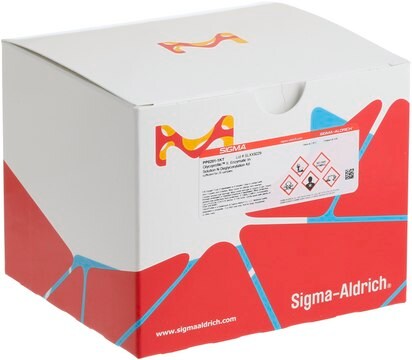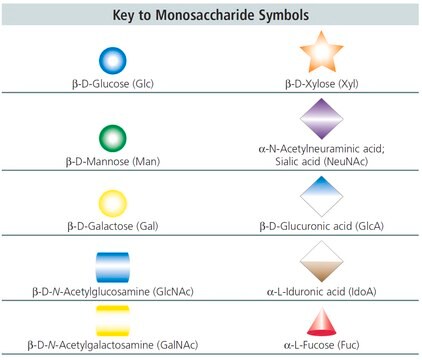P7367
PNGase F from Elizabethkingia meningoseptica
BioReagent, ≥95% (SDS-PAGE), for proteomics
Synonym(s):
N-Glycosidase F, PNGase F from Chryseobacterium meningosepticum, PNGase F from Flavobacterium meningosepticum, Peptide N-glycosidase
About This Item
Recommended Products
biological source
bacterial (Elizabethkingia meningoseptica)
Quality Level
conjugate
(N-linked)
grade
for proteomics
product line
BioReagent
assay
≥95% (SDS-PAGE)
form
powder
shelf life
≥1 weeks at 2‑8 °C (for a reconstituted solution >500 units/ml)
≥1 yr at 2‑8 °C
Solution is stable for at least 3 freeze-thaw cycles
mol wt
~36 kDa
concentration
≥300 units/mL
≥50 units/mL
optimum pH
~8.6
shipped in
wet ice
storage temp.
2-8°C
Looking for similar products? Visit Product Comparison Guide
General description
Application
- for de-N-glycosylation of Zika20virus E protein
- to evaluate coxsackievirus and adenovirus receptor glycosylation using CAR-expressing COS cells
- to verify the N-linked glycosylation of MHC class 1 polypeptide-related sequence A (MICA)
Biochem/physiol Actions
Unit Definition
Related product
signalword
Danger
hcodes
pcodes
Hazard Classifications
Resp. Sens. 1
Storage Class
13 - Non Combustible Solids
wgk_germany
WGK 2
flash_point_f
Not applicable
flash_point_c
Not applicable
ppe
Eyeshields, Gloves, type N95 (US)
Certificates of Analysis (COA)
Search for Certificates of Analysis (COA) by entering the products Lot/Batch Number. Lot and Batch Numbers can be found on a product’s label following the words ‘Lot’ or ‘Batch’.
Already Own This Product?
Find documentation for the products that you have recently purchased in the Document Library.
Customers Also Viewed
Articles
Post-translational modifications such as glycosylation, phosphorylation, and sulfation, to name a few, serve many functions. As a result, the analysis of proteins and their post-translational modifications is particularly important for the study of diseases where multiple genes are known to be involved, such as heart disease, cancer and diabetes.
N-Linked Glycan Strategies.
Our team of scientists has experience in all areas of research including Life Science, Material Science, Chemical Synthesis, Chromatography, Analytical and many others.
Contact Technical Service









